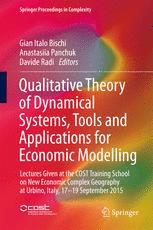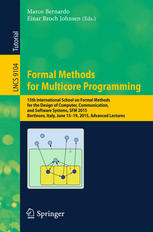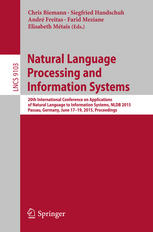Qualitative Theory of Dynamical Systems Tools and Applications for Economic Modelling 1st Edition by Gian Italo Bischi, Anastasiia Panchuk, Davide Radi ISBN 3319332767 9783319332765
$50.00 Original price was: $50.00.$25.00Current price is: $25.00.
Qualitative Theory of Dynamical Systems Tools and Applications for Economic Modelling 1st Edition by Gian Italo Bischi, Anastasiia Panchuk, Davide Radi – Ebook PDF Instant Download/Delivery: 3319332767, 9783319332765
Full download Qualitative Theory of Dynamical Systems Tools and Applications for Economic Modelling 1st Edition after payment

Product details:
ISBN 10: 3319332767
ISBN 13: 9783319332765
Author: Gian Italo Bischi, Anastasiia Panchuk, Davide Radi
The book presents the lectures delivered during a short course held at Urbino University in summer 2015 on qualitative theory of dynamical systems, included in the activities of the COST Action IS1104 “The EU in the new economic complex geography: models, tools and policy evaluation”. It provides a basic introduction to dynamical systems and optimal control both in continuous and discrete time, as well as some numerical methods and applications in economic modelling. Economic and social systems are intrinsically dynamic, characterized by interdependence, nonlinearity and complexity, and these features can only be approached using a qualitative analysis based on the study of invariant sets (equilibrium points, limit cycles and more complex attractors, together with the boundaries of their basins of attraction), which requires a trade-off between analytical, geometrical and numerical methods. Even though the early steps of the qualitative theory of dynamical systems have been in continuous time models, in economic and social modelling discrete time is often used to describe event-driven (often decision-driven) evolving systems. The book is written for Ph.D. and master’s students, post-doctoral fellows, and researchers in economics or sociology, and it only assumes a basic knowledge of calculus. However it also suggests some more advanced topics.
Qualitative Theory of Dynamical Systems Tools and Applications for Economic Modelling 1st Table of contents:
1 Qualitative Methods in Continuous and Discrete Dynamical Systems
1.1 Some General Definitions
1.2 Continuous-Time Dynamical Systems
1.2.1 One-Dimensional Dynamical Systems in Continuous Time
1.2.2 Two-Dimensional Dynamical Systems in Continuous Time
1.2.3 Multi-dimensional Dynamical Systems in Continuous Time
1.3 Discrete-Time Dynamical Systems
1.3.1 One-Dimensional Discrete Dynamical Systems
1.3.2 Two-Dimensional Discrete Dynamical Systems
1.3.3 Discrete Dynamical System Represented by Noninvertible Maps
1.4 An Introduction to Optimal Control in Continuous Time
1.4.1 Bellman’s Optimality Principle: The Hamilton-Jacobi-Bellman Equation
1.4.2 From HJB to Pontryagin’s Maximum Principle
1.4.3 Some Basic Examples
1.4.4 Current Value Formulations
1.4.5 Economic Examples
References
2 Some Aspects on Global Analysis of Discrete Time Dynamical Systems
2.1 Introduction
2.2 Preliminaries
2.3 Stable and Unstable Sets
2.3.1 Stable Manifold Theorem
2.3.2 Stable Sets of Saddle Points and Basins
2.4 Homoclinic Bifurcations
2.4.1 The Notion of a Homoclinic Orbit
2.4.2 Homoclinic Orbits for One-Dimensional Maps
2.4.3 Homoclinic Tangles
2.4.4 Homoclinic Orbits in 2D: Smale Horseshoe
2.5 Crises
2.5.1 Interior Crisis
2.5.2 Boundary Crises
2.6 Conclusions
References
3 Dynamical Analysis of Cournot Oligopoly Models: Neimark-Sacker Bifurcation and Related Mechanisms
3.1 Introduction
3.2 Some Remarks on Neimark-Sacker Bifurcations
3.3 A Cournot Duopoly Model with Differentiated Products: Supercritical NS Bifurcation
3.3.1 Local Stability Analysis
3.3.2 Co-dimension 2 Bifurcation
3.3.3 A Route to Chaos
3.4 An Advertising Cournot Model: Subcritical NS Bifurcation
3.4.1 Local Stability Analysis
3.4.2 Appearance of Curves Due to Homoclinic Bifurcation
3.4.3 Appearance of Curves Due to BCB
3.5 Conclusions
References
4 Some Dynamical Models in Regional Economics: Economic Structure and Analytic Tools
4.1 Introduction
4.2 A General Multi-regional Model
4.2.1 General Framework
4.2.2 Consumers’ Preferences
4.2.3 Production
4.2.4 Trade Costs
4.2.5 Short-Run General Equilibrium
4.2.6 From the Short-Run to the Long-Run
4.2.7 Example 1: A Model of a Custom Union in the Presence of an Outside Region
4.2.8 Example 2: A Two-Country Four-Region Model
4.3 Dynamic Analysis of NEG Models
4.3.1 Peculiarities of NEG Maps
4.3.2 Fixed Points and Their Stability
4.3.3 A 1D Symmetric NEG Map
4.3.4 2D Symmetric NEG Map
4.3.5 2D Nonsymmetric NEG Map
4.4 Conclusion and Further Research Topics
References
5 Dynamic Modeling in Renewable Resource Exploitation
5.1 Introduction
5.2 Basic Models
5.2.1 Unexploited Population Dynamics
5.2.2 Basic Harvesting Modeling
5.3 Commercial Harvesting
5.4 Intertemporal Optimal Harvesting
5.4.1 Single Exploiter and Constant Prices
5.4.2 Single Exploiter and Nonconstant Prices
5.5 Intertemporal Optimal Harvesting with More Exploiters
5.6 Evolutionary Adoption of Harvesting Technology
5.6.1 The Case of Instantaneous Switching
5.6.2 The Case of Discrete Switching and the Hybrid Model
References
6 Dynamic Models of Financial Markets with Heterogeneous Agents
6.1 Introduction
6.2 A Linear Model with Heterogeneous Traders
6.3 A Nonlinear Model with Heterogeneous Traders
6.4 From the Cause to the Consequences
6.4.1 Three One-Dimensional Maps
6.4.2 A Three-Dimensional Map
6.5 An Alternative with Discontinuity
6.6 Conclusions
References
7 A Dynamical Model of Proximal Development: Multiple Implementations
7.1 Introduction
7.2 The Mathematical Formalization
7.3 Multiple Implementation
7.4 Spreadsheet
7.5 R
7.6 C++
7.7 Conclusions
People also search for Qualitative Theory of Dynamical Systems Tools and Applications for Economic Modelling 1st:
qualitative theory of dynamical systems tools
systems theory qualitative research
qualitative theory of dynamical systems
dynamic systems theory quizlet
dynamic systems theory
Tags:
Gian Italo Bischi,Anastasiia Panchuk,Davide Radi,Qualitative Theory,Dynamical Systems Tools,Economic Modelling
You may also like…
Computers - Computer Science
Politics & Philosophy - Government & Politics
Business & Economics
The New Horizon of China’s Economic Law Theory 1st edition by Shouwen Zhang 9811588235 9789811588235
Business & Economics
Education Studies & Teaching - School Education & Teaching












